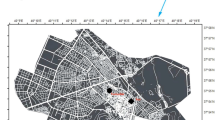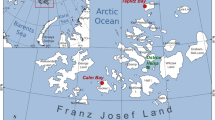Abstract
The human thermal bioclimatic effects of urbanization and natural topographic features (the ocean and hills) were investigated during clear winter nights in Christchurch, New Zealand. Results are presented in terms of the amount of clothing insulation required to balance the body heat budget equation of a standing person with no change in body heat storage. The ordering of urban-rural land use zones from lowest to highest clothing requirements was: CBD, light industrial-commercial, residential and rural. Air temperature accounted for most of the variation in clothing requirement with the model used and weather conditions investigated here followed by environmental thermal radiation. The oceans and hill slopes had an effect comparable to that of most of the urban area and required less clothing than did all land use zones except the urban CBD.
Similar content being viewed by others
References
CLARKE, J. F. and BACH, W. (1971): Comparison of the comfort conditions in different urban and suburban microenvironments. Int. J. Biometeor., 15: 41–54.
FANGER, P. O. (1972): Thermal Comfort — Analysis and Applications in Environmental Engineering. McGraw-Hill, New York.
GAGGE, A. P., STOLWIJK, J. A. J. and NISHI, Y. (1971): An effective temperature scale based on a simple model of human physiological regulatory response. ASHRE Trans., 77: 247–262.
GARNIER, B. J. and LaFLEUR, D. (1972): A study of human comfort in Montreal, Canada. In: Preprints Conference on Urban Environment and Second Conference on Biometeorology. Amer. Meteor. Soc., Boston, 274–279.
KINGHAM, H. H. (1969): Surface temperature patterns in Christchurch at night. N.Z. Geogr., 25: 16–22.
LaFLEUR, D. (1971): Weather and human comfort in Montreal: an example of summer conditions. Clim. Bull. 10: 13–23.
MORGAN, D. L. and BASKETT, R. L. (1974): Comfort of man in the city: an energy balance model of man-environment coupling. Int. J. Biometeor. 18: 184–198.
RYAN, A. P. (1975): Low level air flow patterns in Christchurch on nights of high air pollution potential. In: Proceedings of the 1975 Clean Air Conference. Ann Arbor Science Publishers, Ann Arbor, Michigan, 403–420.
SHAM, M. (1968): The Analysis of Temperature in Christchurch in Relation to the Heat Island Effect. M. A. Thesis, University of Canterbury.
TAPPER, N. (1976): An Investigation of Incoming Short and Long Wave Radiation over Christchurch. M.A. Thesis, University of Canterbury.
TERJUNG, W. (1970): Urban energy balance climatology: a preliminary investigation of the city-man system in downtown Los Angeles. Geogr. Rev., 60: 31–53.
TERJUNG, W., DAKAN, A., HAWKINS, R. et al. (1970): The energy balance climatology of a city-man system. Ann. Ass. Amer. Geogr., 60: 466–492.
TULLER, S. E. (1975): The energy budget of man: variations with aspect in a downtown urban environment. Int. J. Biometeor., 19: 2–13.
Tuller, S. E. (1977): Some aspects of urban climate in Christchurch. N.Z. J. Geogr., 63: 9–19.
TULLER, S. E. (1980): The effects of a foehn wind on human thermal exchange: the Canterbury nor'wester. N.Z. Geogr., 66: in press.
Author information
Authors and Affiliations
Rights and permissions
About this article
Cite this article
Tuller, S.E. Effects of a moderate sized city on human thermal bioclimate during clear winter nights. Int J Biometeorol 24, 97–106 (1980). https://doi.org/10.1007/BF02245549
Received:
Issue Date:
DOI: https://doi.org/10.1007/BF02245549




